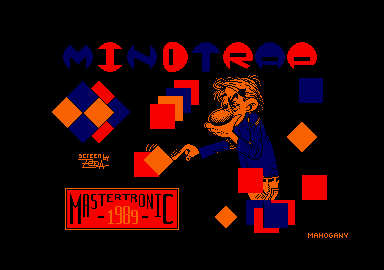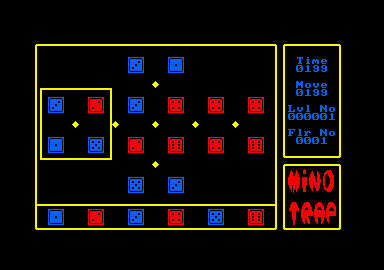Retro Replay Review
Gameplay
Mindtrap offers a deceptively simple premise that unfolds into a deep and engaging puzzle experience. At its core, the game presents you with up to 24 colored, spotted blocks—much like oversized dice—that must be arranged into columns matching their numerical value. The straightforward goal belies a surprisingly intricate system of movement, timing, and spatial reasoning that will challenge both newcomers and seasoned puzzle veterans.
The primary mechanic revolves around a crosshair that covers four blocks at a time. By holding down the fire button and pushing left or right, you can rotate these blocks through four positions in sequence. Mastery of this control scheme is essential, as you’ll often need to execute precise rotations under pressure. The tactile feel of manipulating a quartet of blocks at once gives Mindtrap a distinctive physicality that sets it apart from more traditional sliding-block games.
As you progress, the difficulty ramps up considerably. Early levels allow generous space and clear cog placements, but soon you’ll face columns of two and zones devoid of cogs where movement is impossible. These obstacles force you to think several steps ahead, planning not just for a single rotation but for an entire cascade of moves. Later stages introduce multiple floors that require seamless switching of blocks between levels, adding a vertical dimension to your problem-solving arsenal. With 999,999 levels promised, the gameplay depth feels virtually endless.
Graphics
Visually, Mindtrap embraces an abstract, minimalist art style that keeps the focus firmly on the puzzles. The blocks are brightly colored and sport clear numerical spots, ensuring readability even in the most cramped levels. Backgrounds remain unobtrusive, using muted tones and subtle gradients to provide context without distracting from the core gameplay.
The user interface is clean and intuitive. Cogs, columns, and floor boundaries are rendered with crisp lines and consistent iconography, making it easy to distinguish between movable and immovable areas at a glance. Animations for block rotations are smooth, with just the right amount of easing to convey momentum without feeling sluggish.
While the game doesn’t aim for photo-realism or flashy special effects, its visual design excels in clarity and functionality. Every element on-screen serves a purpose, and the overall aesthetic contributes to a zen-like atmosphere where puzzles become meditative exercises rather than frantic challenges. For players who appreciate form following function, Mindtrap’s graphics hit the sweet spot.
Story
Mindtrap doesn’t offer a traditional narrative with characters or dialogue. Instead, it presents an abstract “mental labyrinth” concept, inviting players to immerse themselves in the pure act of problem-solving. If you’re looking for a deep storyline or cinematic cutscenes, this might not be the game for you—but that’s precisely the point.
The absence of a conventional plot allows Mindtrap to maintain an unbroken focus on gameplay. Each level feels like a new chamber in an ever-expanding puzzle temple, and the lack of narrative interruptions enhances the meditative flow. In this sense, the game’s story is your own progression, your growing skill set, and the satisfaction of conquering increasingly devious arrangements.
For puzzle enthusiasts who find story elements superfluous, this minimalist approach is refreshing. Mindtrap’s “story” is written in colored blocks and cog placements rather than lines of dialogue. Your personal journey emerges from puzzle mastery, making each completed challenge feel uniquely satisfying.
Overall Experience
Mindtrap stands out as a meticulously crafted puzzler that rewards patience, planning, and creativity. The sheer number of levels ensures that you’ll be occupied for weeks—if not months—while the gradual introduction of new mechanics keeps the experience fresh. Whether you’re deftly navigating single floors or juggling blocks across multiple layers, the gameplay loop remains engaging from start to finish.
Replayability is one of Mindtrap’s strongest suits. With nearly a million unique layouts, the odds of encountering the same puzzle twice are vanishingly small. For players who thrive on “just one more level” motivation, this game is a dream come true. The design also lends itself well to friendly competition—challenge friends to see who can clear levels fastest or with the fewest moves.
In summary, Mindtrap delivers a focused, rewarding puzzle experience that will appeal to fans of sliding-block and abstract strategy games. Its clean presentation, tight controls, and virtually limitless content make it a standout choice for anyone seeking a cerebral gaming session. If mental gymnastics are your preferred form of entertainment, you’ll find a lot to love in this meticulously engineered puzzler.
 Retro Replay Retro Replay gaming reviews, news, emulation, geek stuff and more!
Retro Replay Retro Replay gaming reviews, news, emulation, geek stuff and more!









Reviews
There are no reviews yet.